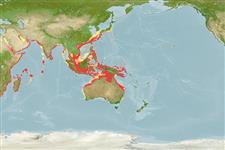Common names from other countries
Пластиножаберные (акулы и скаты) (sharks and rays) >
Carcharhiniformes (Ground sharks) >
Hemigaleidae (Weasel sharks)
Etymology: Hemipristis: hemi-, from hemisys (Gr.), half; pristis, from pristes (Gr.), sawyer (but here meaning saw), allusion not explained, possibly referring to how marginal serrations of teeth of H. serra (type species, a fossil) do not extend over the entire length of each tooth. (See ETYFish); elongata: Latin for prolonged, referring to its long and slim body. (See ETYFish).
More on author: Klunzinger.
Environment: milieu / climate zone / depth range / distribution range
экология
морской демерсальный; пределы глубины 1 - 130 m (Ref. 6871). Tropical; 41°N - 34°S, 12°E - 156°E (Ref. 6871)
Indo-West Pacific: Red Sea and southeast Africa, including Persian Gulf (Ref. 68964) to Philippines, north to China, south to Australia.
Length at first maturity / Size / Вес / Возраст
Maturity: Lm ?, range 120 - ? cm
Max length : 240 cm TL самец/пол неопределен; (Ref. 5578); common length : 200 cm TL самец/пол неопределен; (Ref. 13567)
колючие лучи спинного плавника (общее число) : 0; колючие лучи анального плавника: 0. A slender weasel shark with a long, broadly rounded snout, large curved, saw-edged teeth in the upper jaw, and hooked lower teeth protruding from mouth; gill slits long; fins strongly curved (Ref. 5578). Light grey or bronzy with no prominent markings (Ref. 5578).
A coastal species, found inshore and offshore on the continental and insular shelves (Ref. 244). Feeds on sharks, rays and bony fishes (Ref. 244); also cephalopods (Ref. 13567). Viviparous (Ref. 50449). Thought to be potentially dangerous because of its large, fearsome teeth and shallow-water habitat, but has not been recorded in an attack on people (Ref. 244). Caught regularly by inshore gillnet, bottom trawl (occasionally) and longline fisheries (Ref.58048). Regularly taken in artisanal fisheries (Ref. 13567). Utilized fresh for human consumption, liver processed for vitamins, fins used in the oriental shark fin trade, and by-products processed into fishmeal (Ref. 244). Most adults below 200 cm (Ref. 30573).
Life cycle and mating behavior
Maturities | размножение | Spawnings | Egg(s) | Fecundities | личинки
Viviparous, with 2 to 11 young in a litter (Ref. 6871) after a gestation period of 7-8 months; possibly reproduces in alternate years (Ref.58048). Size at birth about 45-52 cm TL (Ref. 13567, Ref.58048). Distinct pairing with embrace (Ref. 205).
Compagno, L.J.V., 1984. FAO Species Catalogue. Vol. 4. Sharks of the world. An annotated and illustrated catalogue of shark species known to date. Part 2 - Carcharhiniformes. FAO Fish. Synop. 125(4/2):251-655. Rome: FAO. (Ref. 244)
Статус Красного Списка МСОП (Ref. 130435)
CITES (Ref. 128078)
Not Evaluated
Угроза для людей
Traumatogenic (Ref. 5213)
Использование человеком
рыболовство: коммерческий
дополнительная информация
инструменты
Специальные отчеты
Скачать в формате XML
ресурсы в Интернет
Estimates based on models
Preferred temperature (Ref.
115969): 23.8 - 29, mean 27.9 (based on 2110 cells).
Phylogenetic diversity index (Ref.
82804): PD
50 = 1.0039 [Uniqueness, from 0.5 = low to 2.0 = high].
Bayesian length-weight: a=0.00363 (0.00147 - 0.00899), b=3.07 (2.86 - 3.28), in cm Total Length, based on LWR estimates for this (Sub)family-body shape (Ref.
93245).
Trophic level (Ref.
69278): 4.3 ±0.3 se; based on diet studies.
устойчивость к внешним воздействиям (Ref.
120179): очень низкий, минимальное время удвоения популяции более 14 лет (Fec=2).
Fishing Vulnerability (Ref.
59153): Very high vulnerability (90 of 100).
